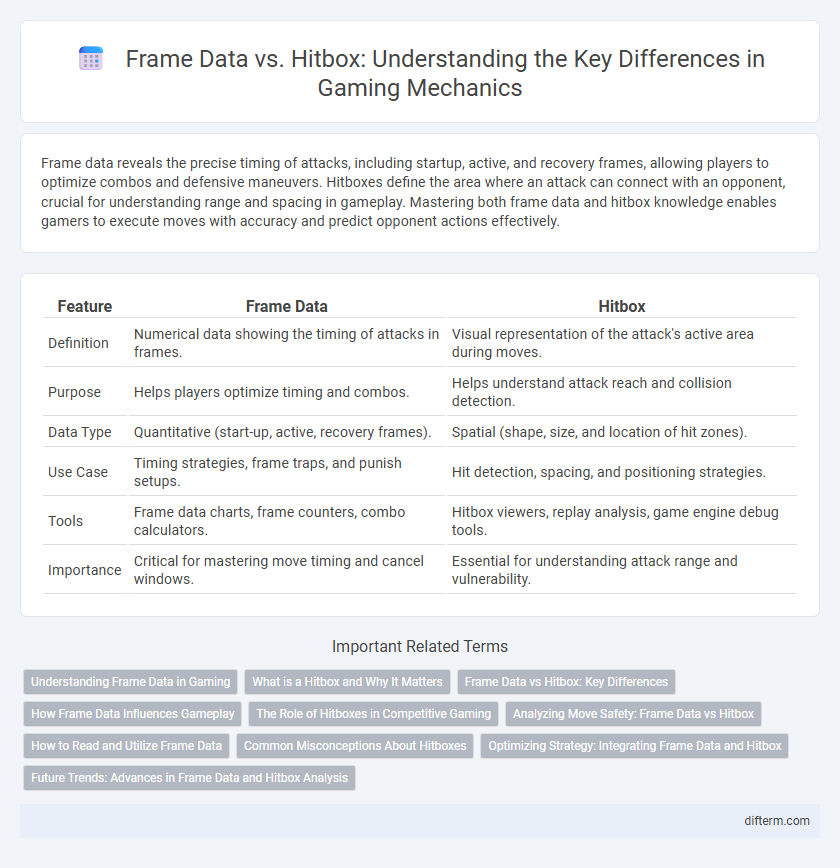Frame data reveals the precise timing of attacks, including startup, active, and recovery frames, allowing players to optimize combos and defensive maneuvers. Hitboxes define the area where an attack can connect with an opponent, crucial for understanding range and spacing in gameplay. Mastering both frame data and hitbox knowledge enables gamers to execute moves with accuracy and predict opponent actions effectively.
Table of Comparison
| Feature | Frame Data | Hitbox |
|---|---|---|
| Definition | Numerical data showing the timing of attacks in frames. | Visual representation of the attack's active area during moves. |
| Purpose | Helps players optimize timing and combos. | Helps understand attack reach and collision detection. |
| Data Type | Quantitative (start-up, active, recovery frames). | Spatial (shape, size, and location of hit zones). |
| Use Case | Timing strategies, frame traps, and punish setups. | Hit detection, spacing, and positioning strategies. |
| Tools | Frame data charts, frame counters, combo calculators. | Hitbox viewers, replay analysis, game engine debug tools. |
| Importance | Critical for mastering move timing and cancel windows. | Essential for understanding attack range and vulnerability. |
Understanding Frame Data in Gaming
Frame data in gaming refers to the detailed breakdown of animation frames that dictate the timing of moves, including startup, active, and recovery phases. Understanding frame data enables players to optimize attack windows and defend effectively by knowing when their character is vulnerable or invincible. Mastery of frame data analysis is essential for competitive gameplay, allowing precise execution and strategic advantage over opponents.
What is a Hitbox and Why It Matters
A hitbox in gaming refers to the invisible shape or area assigned to a character or object that determines where attacks can connect. Understanding hitboxes is essential for players to execute precise combos, avoid damage, and capitalize on opponents' vulnerabilities. Accurate knowledge of hitbox properties enhances gameplay strategy and competitive performance.
Frame Data vs Hitbox: Key Differences
Frame data represents the timing of moves in gaming, detailing startup, active, and recovery frames to quantify attack speed and vulnerability. Hitbox refers to the spatial area where an attack can connect, defining the collision boundaries between characters or objects. Understanding the key differences between frame data and hitbox is essential for optimizing attack strategies and defensive maneuvers in competitive gameplay.
How Frame Data Influences Gameplay
Frame data provides precise timing information on move startup, active frames, and recovery, allowing players to optimize attack sequences and defensive maneuvers. Accurate frame data analysis helps in identifying punish windows and perfecting combos, giving players a strategic advantage in competitive gaming. Understanding frame data directly impacts gameplay by enabling better decision-making and reaction times during matches.
The Role of Hitboxes in Competitive Gaming
Hitboxes define the exact areas where characters or attacks can interact, making them essential for precise collision detection in competitive gaming. Unlike frame data, which provides timing information for moves, hitboxes determine spatial validity for hits, blocks, and counters, directly impacting player strategies and outcomes. Mastery of hitbox recognition and manipulation often separates high-level competitors, influencing game balance and competitive fairness.
Analyzing Move Safety: Frame Data vs Hitbox
Analyzing move safety in gaming requires a deep understanding of frame data and hitbox interactions. Frame data reveals the startup, active, and recovery durations of a move, indicating when a player is vulnerable or can counterattack. Hitbox information complements this by showing the spatial reach and potential impact zones, enabling precise predictions about move effectiveness and punish windows.
How to Read and Utilize Frame Data
Frame data reveals critical timing details for each move in fighting games, showing startup, active, and recovery frames that determine vulnerability and advantage. Understanding hitbox locations clarifies which areas of a character can hit or be hit, improving spatial awareness during combos and counters. Combining frame data analysis with hitbox visualization allows players to optimize attack timing and positioning, maximizing damage while minimizing risk.
Common Misconceptions About Hitboxes
Many gamers mistakenly believe hitboxes directly determine a move's damage or speed, but hitboxes primarily define the area where an attack can connect with an opponent. Frame data provides precise timing information about startup, active, and recovery frames, which is essential for understanding move effectiveness and vulnerability. Understanding the distinction between hitboxes and frame data is crucial for optimizing gameplay and improving competitive strategies.
Optimizing Strategy: Integrating Frame Data and Hitbox
Optimizing strategy in gaming demands a precise integration of frame data and hitbox analysis to maximize attack efficiency and defensive timing. Frame data quantifies the startup, active, and recovery frames of moves, enabling players to predict cooldowns and execute combos with improved accuracy. Hitbox information complements this by revealing the spatial reach and vulnerability zones of attacks, allowing players to exploit positioning and optimize hit confirmation in high-level play.
Future Trends: Advances in Frame Data and Hitbox Analysis
Emerging technologies in frame data and hitbox analysis leverage machine learning algorithms to predict move properties and collision detection with unprecedented accuracy. Real-time data visualization tools enable players and developers to dissect animations frame-by-frame, enhancing strategy formulation and game balancing. Integration of augmented reality and AI-driven analytics is set to revolutionize competitive gaming by providing deeper insights into hitbox interactions and frame advantage windows.
Frame Data vs Hitbox Infographic

 difterm.com
difterm.com